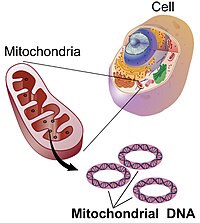
Photo from wikipedia
Estrogens exert many effects on mitochondrial function via targeting both nuclear and mitochondrial encoded genes. Recent reports indicate that the expression of mitochondrial fusion and fission proteins might be downstream… Click to show full abstract
Estrogens exert many effects on mitochondrial function via targeting both nuclear and mitochondrial encoded genes. Recent reports indicate that the expression of mitochondrial fusion and fission proteins might be downstream targets of estradiol (E2). However, there has been no quantitative evaluation of E2 effects on mitochondrial network characteristics. We used MiNA, the Mitochondrial Network Analysis tool recently developed in our laboratory, to quantitatively measure mitochondrial network features in cells treated with E2 or the selective estrogen receptor-α and β modulators (SERMs) propylpyrazole triol (PPT) and diarylpropionitrile (DPN), respectively. 48h treatment of mouse C2C12 myoblasts with various concentrations of either E2 or DPN, but not PPT, significantly modified mitochondrial network morphology. Both E2 and DPN approximately doubled the number of mitochondrial networks as well as the number of branches per network, while PPT had no effect on these parameters. Similarly, both E2 and DPN significantly increased the mitochondrial footprint, a measure of mitochondrial abundance, while PPT failed to modulate this feature. These data indicate that ER-β agonists strongly promote mitochondrial fusion. Thus, these observations provide initial quantitative evidence of beneficial actions of SERMs such as DPN as a pharmacological tool for targeting mitochondrial fusion in pathological conditions characterized by deficient mitochondrial network formation, such as certain neurodegenerative diseases and cancers.
Journal Title: Free Radical Biology and Medicine
Year Published: 2017
Link to full text (if available)
Share on Social Media: Sign Up to like & get
recommendations!